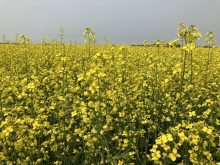RIDICULOUS RATES
Re: SaskPower rate increase.
I read in the (Saskatoon) StarPhoenix that SaskPower is putting up its rates 5.5 percent in 2014, five percent in 2015 and five percent in 2016. That comes to over 17 percent by 2016.
This is going to cause a big round of inflation because all government and crown corporation union employees will need a big increase in wages. So up goes our SaskEnergy, SaskTel and SaskPower rates.
Some businesses can pass some of this on, but it makes some of us uncompetitive with neighbouring provinces. It makes manufacturers less competitive with the rest of the world. Farmers have no way of passing this ridiculous cost on.
Read Also

Growth plates are instrumental in shaping a horse’s life
Young horse training plans and workloads must match their skeletal development. Failing to plan around growth plates can create lifelong physical problems.
I hope the rate review board and government puts a stop to this. Write your MLA or get rid of the crowns.
Warren Iverson,
Glaslyn, Sask.
PRICEY COMMISSIONS
Re: Nov. 28 WP letters to the editor from Leo Howse and Kyle Korneychuk.
I have to state that I agree with the statements from these two gentlemen. As a retired farmer, I have been an advocate of a strong Canadian Wheat Board and Canadian Grain Commission.
The people who wanted to rid the CWB of its monopoly powers knew that Saskatchewan would set up two provincial grain commissions in Saskatchewan that would be very expensive to operate. Cherilyn Nagel Jolly and Bill Cooper were two such persons.
Now Ms. Jolly is wanting to be elected to such a commission and collect per diems every time they meet. This is how they have been operating in Alberta for years.
When the CWB was in charge of collecting the checkoff for the CGC, the CWB charged a very low administration fee of less than $2,000 per year. Now that Ms. Jolly and Bill Cooper have helped destroy the single desk of the CWB, they are now increasing your cost of operating a Saskatchewan barley and a Saskatchewan wheat commission. How much is each board member going to be paid? How much is the government executive director going to be paid?
It has been stated that about half of the money collected will be spent on research. I guess the other half will be mostly wages. Pretty expensive wheat and barley commissions and a fantastic job creation program.
David Bailey,
REPREHENSIBLE ACTION
The first consideration of any government is the health and safety of the people. What will it take to convince the Manitoba government that it should never allow arsenic to be released into our surface waters?
I consider such action reprehensible, yet that is exactly what the province has permitted Virden to do, with arsenic that has been removed from the water source at the town’s treatment plant.
In recent correspondence, the province informed me that arsenic recovered from the Virden water treatment plant will continue to be allowed to be released into a surface water stream: Gopher Creek.
My concern is that, over time, this will significantly add to surface water contamination and pollute the environment, creating unknown consequences, and compromise future generations….
Manitoba Conservation assumes that minute concentrations are quite harmless to those who would consume water from this source.
But time takes its toll. Health issues will come to pass and people will wonder why….
The Criminal Code of Canada states it is an indictable offence to place poison in a place where it may be easily consumed by livestock. There is no mention with respect to humans being victims. Why are poison risks to humans not included? I can only assume that the writers took for granted that everyone would be aware and realize the implications of health risks where poison was involved. Apparently not.
Manitoba Health has told me that arsenic should never be put in a water source. Good for them. They have recognized the precautionary principle.
And rather than be confronted with related health issues of future generations and increased health care costs, they have taken a stand against arsenic. They know that no one is immune or invincible to arsenic poisoning.
As the presiding judge in the tainted blood inquiry, justice Horace Krever stated almost two decades ago, “The relationship between a regulator and the regulated must never become one in which the regulator loses sight of the principle that it only regulates in the public interest and not in the interest of the regulated.”
It is government’s duty to protect the public interest.
As such, I urge that the province require Virden to bring in and utilize a safe method of arsenic disposal.
John Fefchak,
Virden, Man.
TOXIC TREADMILL
Re: WP op-ed Oct. 31, Greenpeace Golden Rice stance baffling.
When I read that a founding member of Greenpeace is supporting technology that should be “against his grain,” I found it odd.
A simple Wikipedia search reveals the truth. Patrick Moore was last involved in the Greenpeace movement a quarter of a century ago. Who would acknowledge a business card that is 25 years old?
Since 1990, Patrick Moore has been paid to promote anything and everything from nuclear power to strip mining, fish farming and now GM golden rice. He has a consulting firm that provides public relations efforts, lectures, lobbying, opinions and committee participation to government and industry. His company is ironically called Green Spirit.
As for golden rice, what is so golden? U.S. researchers were fired for testing the genetically modified rice on children in China without parental consent. The key researcher, Guangwen Tang, is banned from doing any more research for two years.
Why does Canada promote genetically modified food crops that endanger our long-term standing as far as food production is concerned?
Our crops were assumed to be safe. Before GMOs, all Canadian crops were by definition safe and sound and never had any problems with rejection by European countries. Now, Canadian corn, canola, soy and sugar are largely rejected in Europe, except as animal feed, because they are genetically engineered.
The very short-term gain of in-creased yield is offset by increased use of chemicals and retrograding rapidly into the use of more toxic chemicals like dicamba and 2,4D-like chemicals due to weeds that become resistant to Roundup herbicide.
Where are we going on this toxic treadmill? It is becoming apparent that glyphosate is hazardous to the health of animals, humans and the environment.
Dr. Stephanie Seneff, a senior research scientist from MIT, along with Anthony Samsel, recently published a paper indicating that gastrointestinal disorders, obesity, diabetes, heart disease, cancer and a host of other diseases are linked to the disruption of P450 (CYP) enzymes, which detoxify xenobiotics. Gut bacteria are also negatively impacted and inflammation damages cellular systems over time.
I see a big future in organic food production as consumers become aware of the consequences of eating genetically modified food.
Heidi Osterman,
certified nutritionist,
Kelowna, B.C.
FOOD ISSUES COMPLEX
We are constantly fed the line that high–input agriculture, “Big Ag,” is the answer for feeding the world, and that organic food is a frivolous luxury and not a viable option. The fact is that more and more reports from development agencies that work in poor countries where hunger is an issue are suggesting that ecological farming techniques, such as organic or near organic, are crucial.
These techniques, which include composting, water and soil conservation, agriforestry and crop diversity, are found to be at least as important as agrichemicals and biotechnology for farmers in the Third World, especially where the soils are degraded and markets marginalized. They simply cannot afford to buy chemical inputs. As well, the ecological practices give producers a better chance of managing the stresses of climate fluctuations.
I would suggest that the world’s food issues are very complex and will require a whole range of approaches to meet the demands of an ever-burgeoning population. It will require a more thoughtful approach than by simply heaping scorn on organic farming and pandering to Big Ag.
Mark Gimby,
Saskatoon, Sask.














